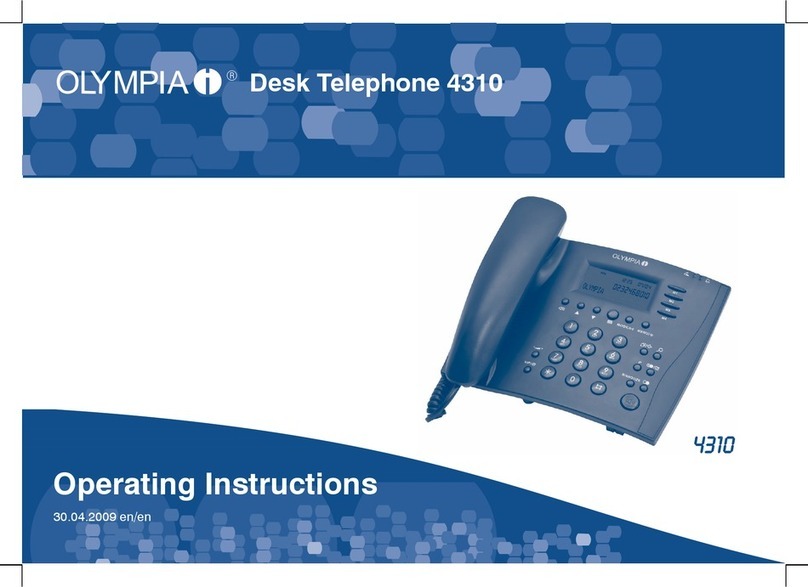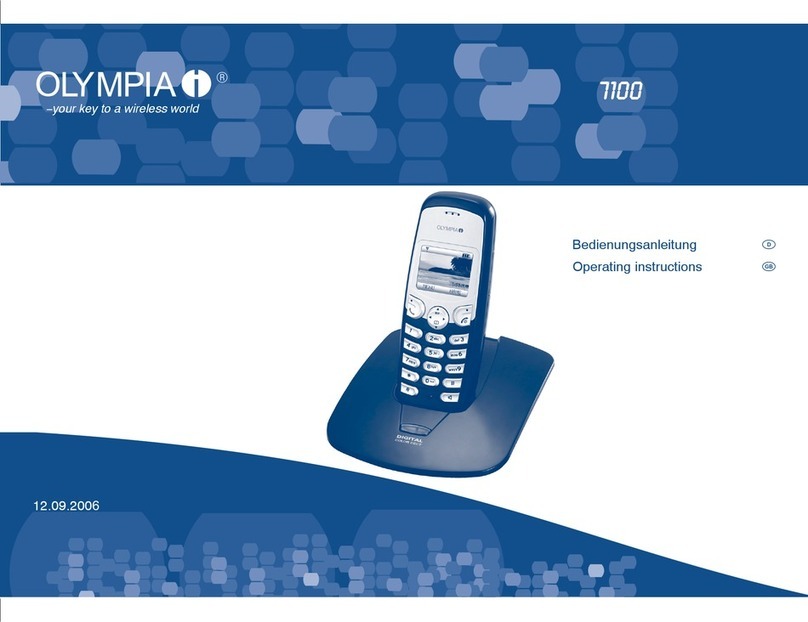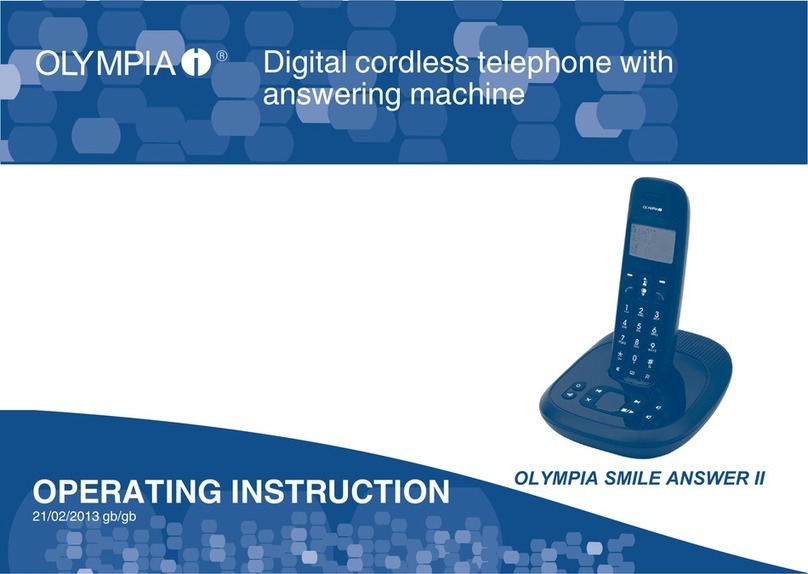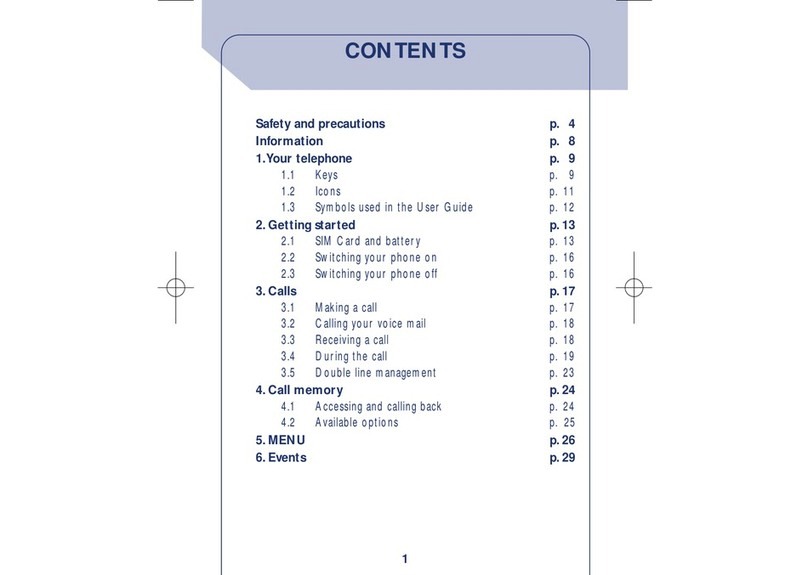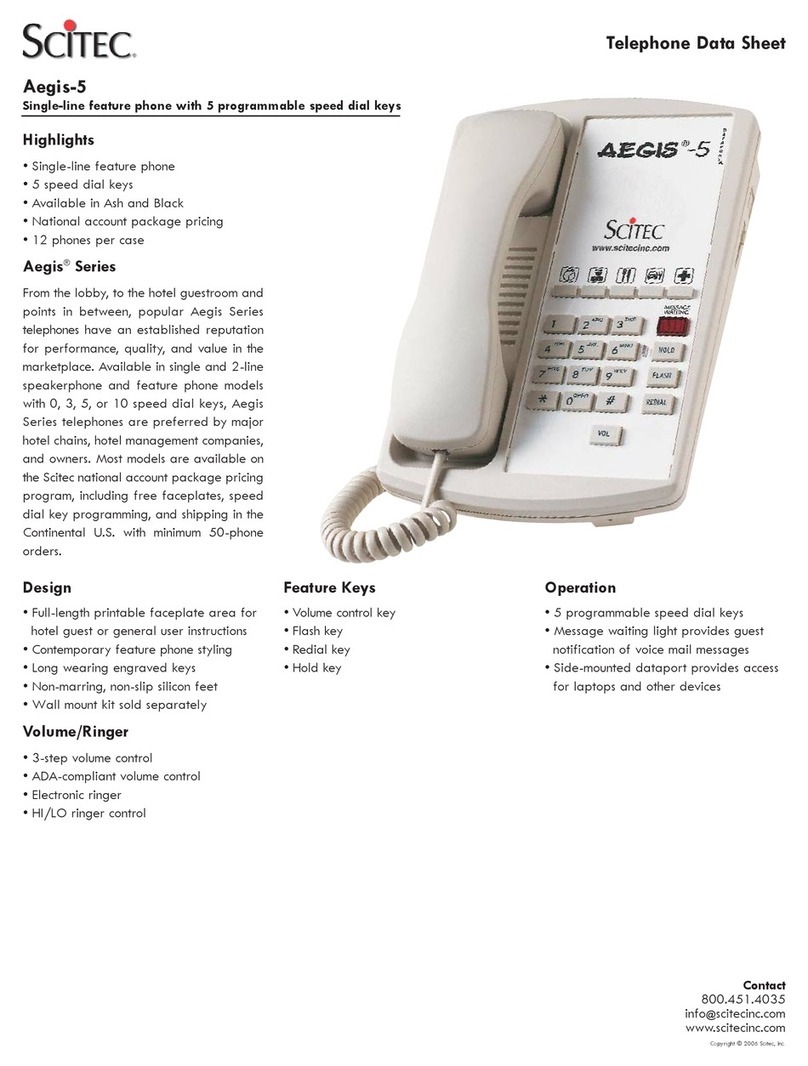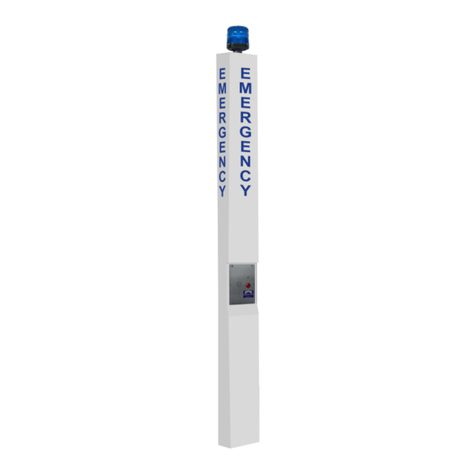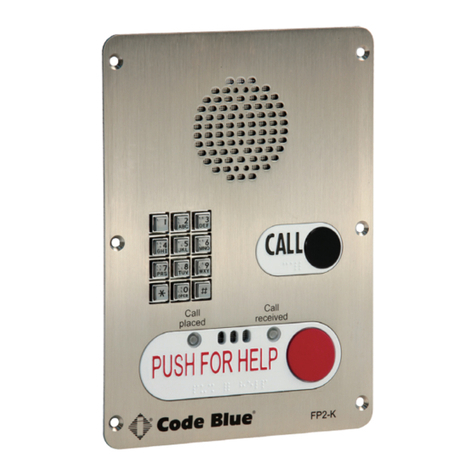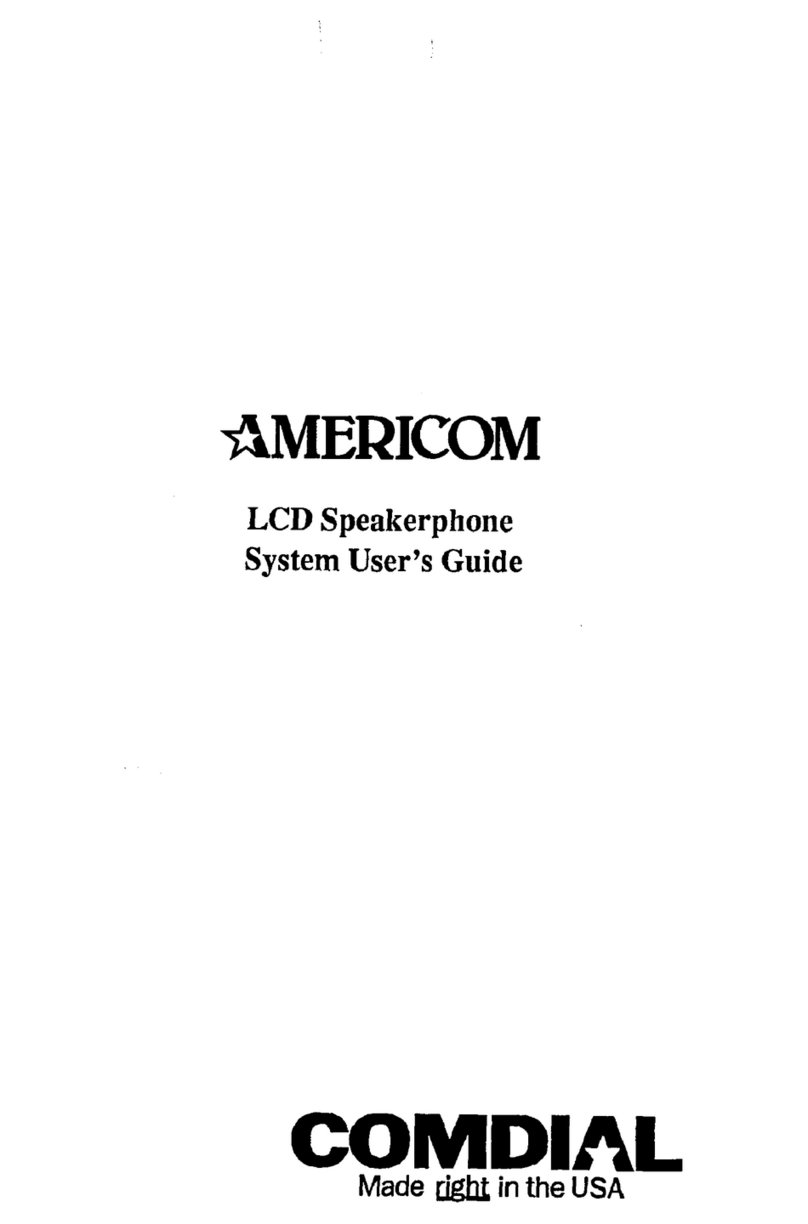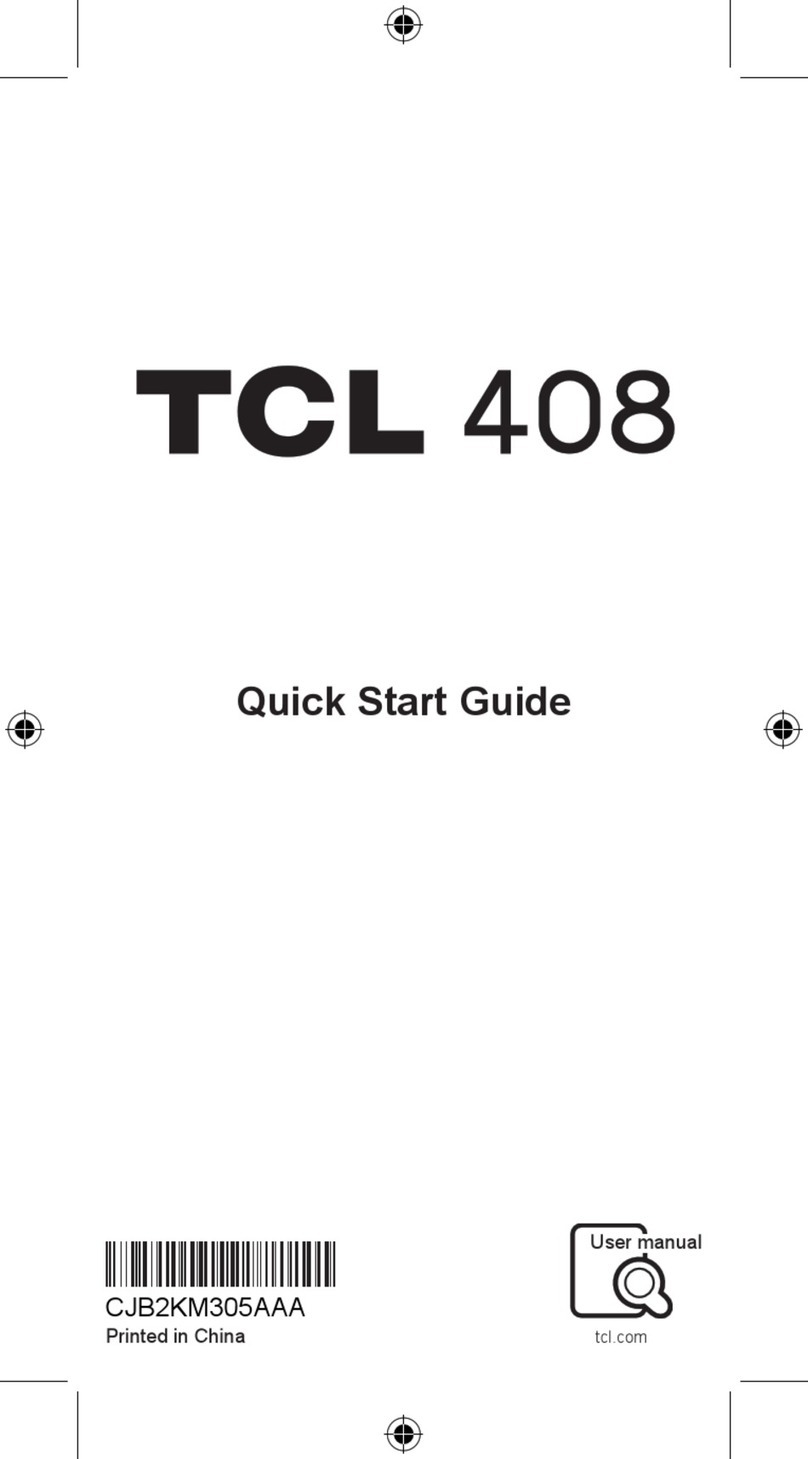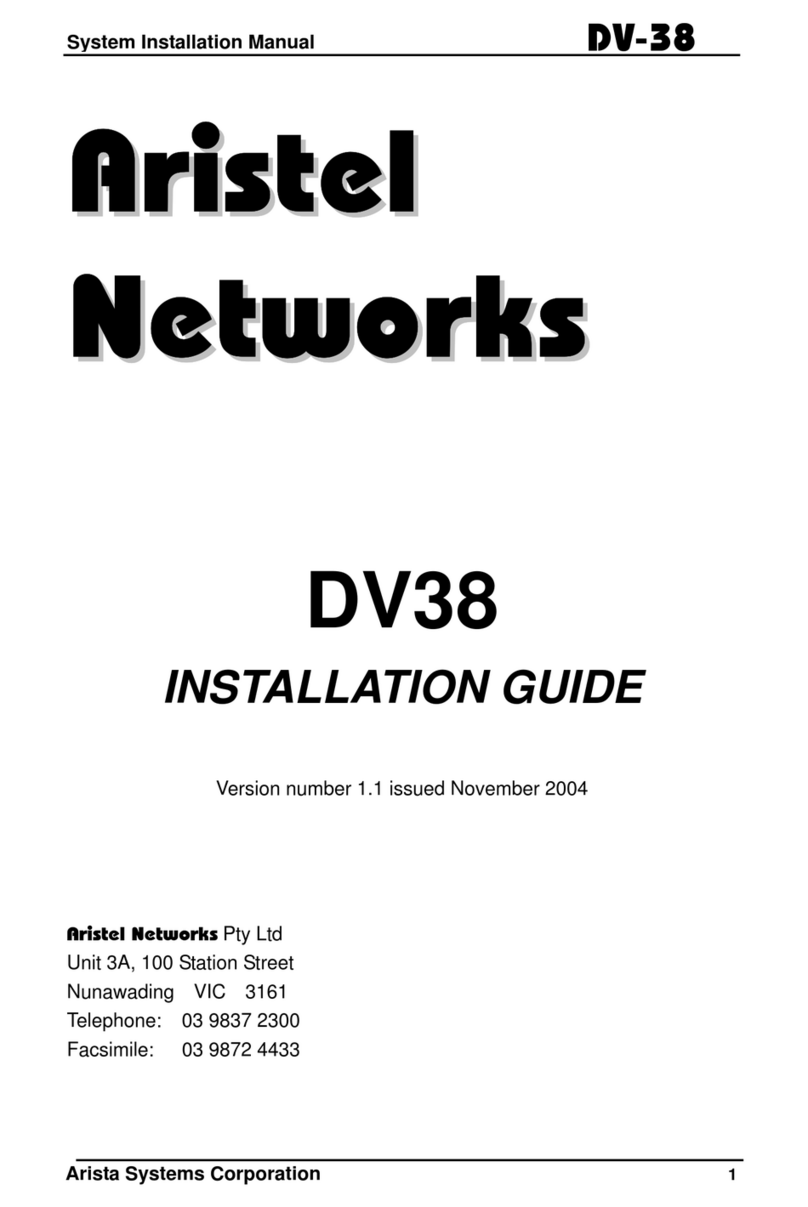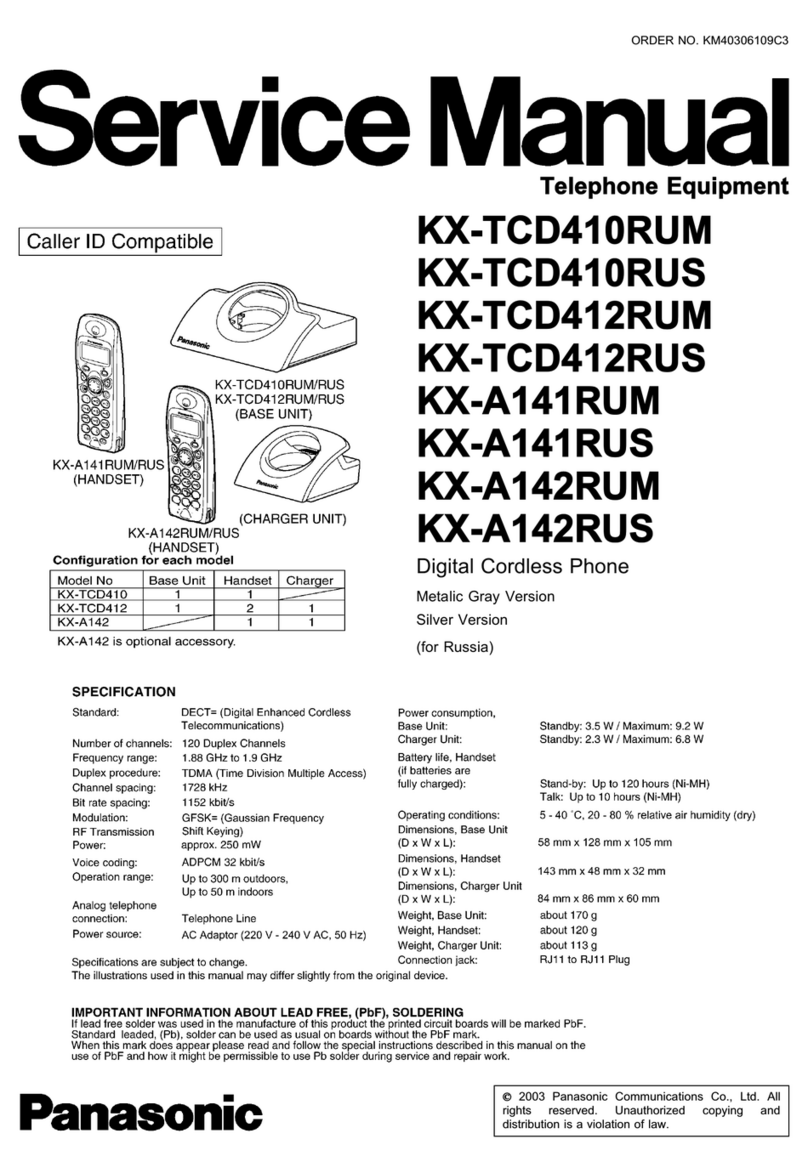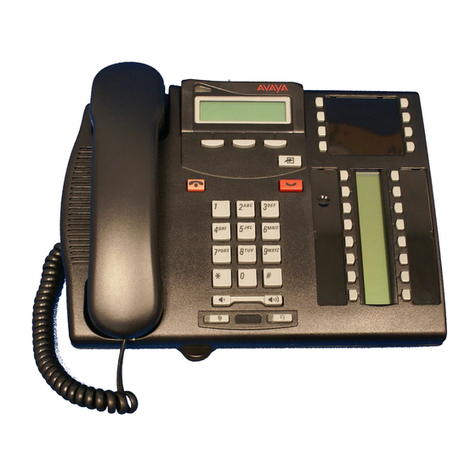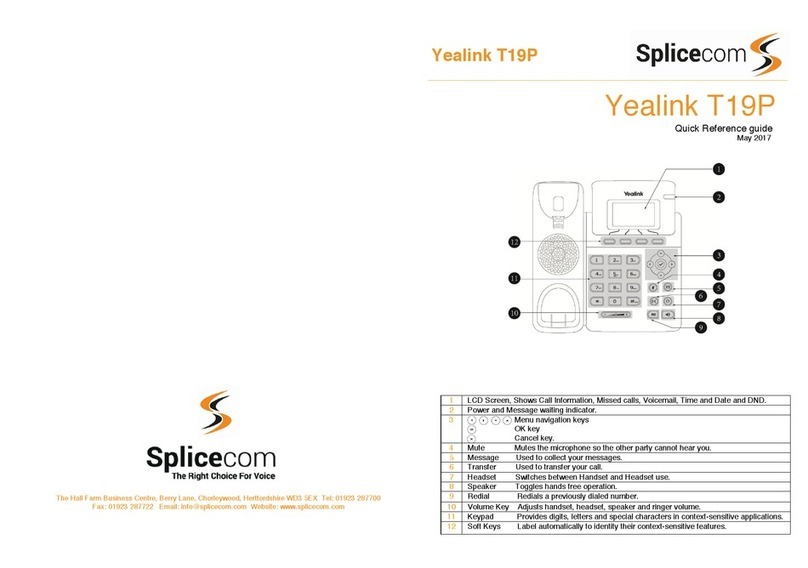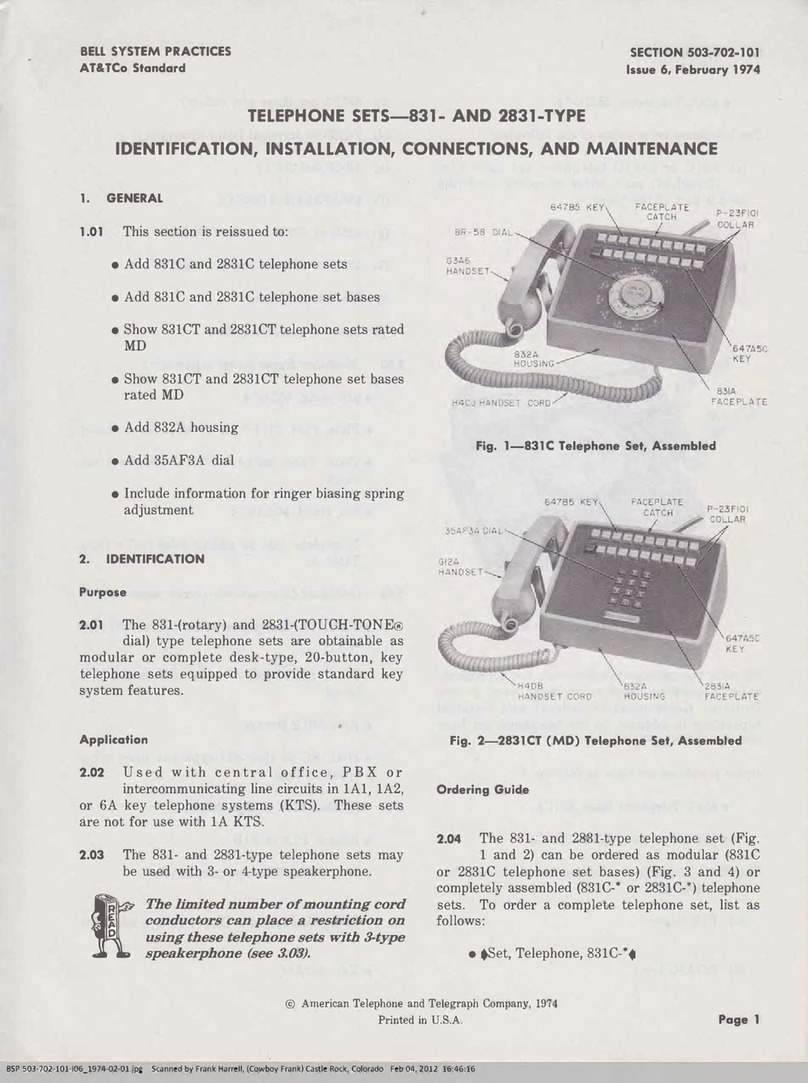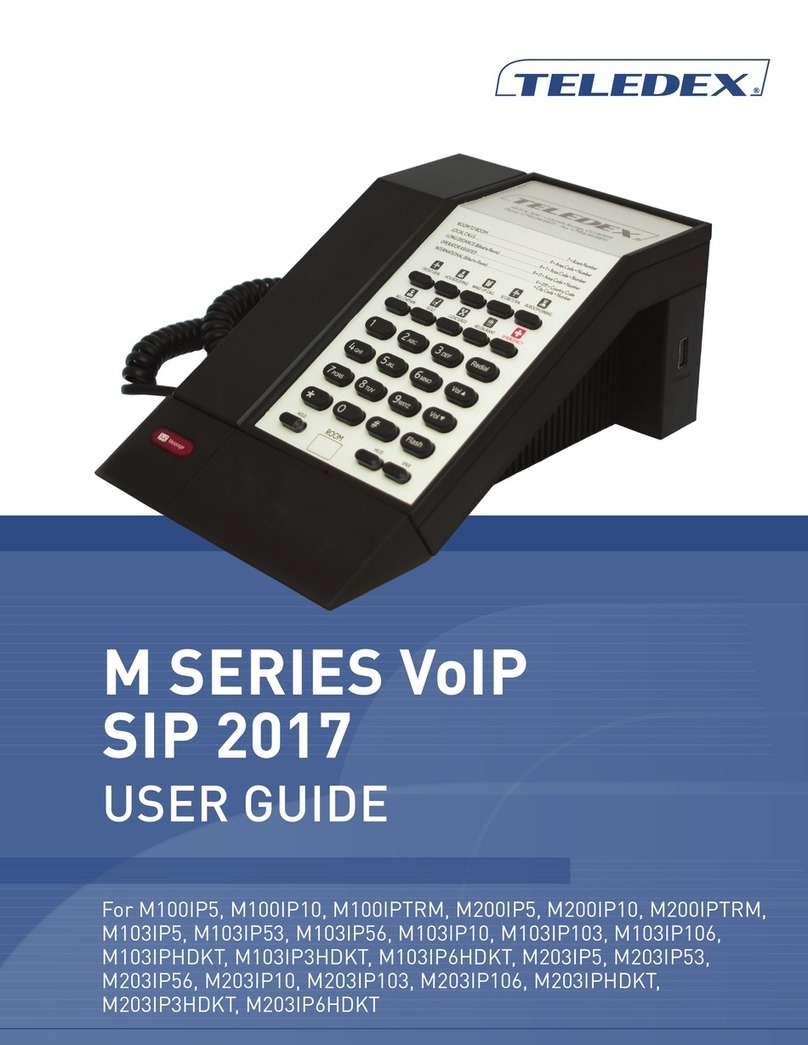Olympia T 1001 C User manual

SWichtige Sicherheitsanweisungen
Um ein zuverlässiges Arbeiten mit dem Telefon zu gewährleisten, beachten Sie bitte Folgendes:
SLesen Sie diese Anweisungen bitte sorgfältig durch und beachten Sie sie bei der Handhabung Ihres Geräts.
SStellen Sie das Telefon auf eine rutschfeste Unterlage und verlegen Sie die Anschluss−Schnüre unfallsicher.
SSetzen Sie das Gerät weder extremen Temperaturen noch hoher Luftfeuchtigkeit aus und schützen Sie es vor direkter
Sonneneinstrahlung und starker Staubeinwirkung.
SReinigen Sie das Gerät mit einem weichen feuchten Tuch. Verwenden Sie keine Lösungsmittel oder aggressive
Reinigungsmittel.
SSchließen Sie nur zugelassenes Zubehör an.
SÖffnen Sie nie das Gerät. Falls Sie das Gehäuse des Geräts öffnen, besteht die Gefahr eines Stromschlags. Außerdem
erlischt die Garantie.
SReparaturen an defekten Geräten sollten Sie immer nur vom Kundendienst vornehmen lassen.
SHaftungsausschluss
Wir übernehmen keine Garantie für die Richtigkeit der Informationen, die sich auf technische Eigenschaften sowie die hier
vorliegende Dokumentation beziehen. Das in dieser Dokumentation beschriebene Produkt und dessen Zubehör unterliegen einer
ständigen Verbesserung und Weiterentwicklung. Aus diesem Grund behalten wir uns das Recht vor, Komponenten, Zubehör,
technische Spezifikationen sowie die hier vorliegende Dokumentation des Produkts ohne vorherige Ankündigung jederzeit zu ändern.
SBestimmungsgemäße Verwendung
Dieses Telefon ist geeignet für das Telefonieren innerhalb eines Telefonnetzes. Jede andere Verwendung gilt als
nicht bestimmungsgemäß. Eigenmächtige Veränderungen oder Umbauten, die nicht in dieser Bedienungsanleitung
beschrieben sind, sind nicht zulässig.
SHinweise zur Entsorgung
Die Umsetzung europäischen Rechts in nationale Gesetze und Verordnungen verpflichtet Sie zur sachgerechten
Entsorgung von Gebrauchsgütern. Dies dient dem Schutz von Personen und Umwelt. Das nebenstehende Symbol
bedeutet, dass elektrische und elektronische Altgeräte getrennt vom Hausmüll zu entsorgen sind.
Verpackungsmaterialien entsorgen Sie entsprechend den lokalen Vorschriften.
Schnurgebundenes Telefon
T 1001 C
RSInstallation
Verpackungsinhalt
Zum Lieferumfang des Telefons gehören eine Hörerablage (Basis), ein Handteil mit Spiralkabel, eine TAE−Leitung und diese
Bedienungsanleitung.
Bitte prüfen Sie den Verpackungsinhalt genau. Sollte etwas fehlen oder durch den Transport beschädigt sein, dürfen Sie dieses
Telefon NICHT in Betrieb nehmen! Wenden Sie sich in diesem Fall mit dem Kaufbeleg an Ihren Fachhändler oder direkt an das
OLYMPIA Service−Center.
Hinweis: Heben Sie die Verpackung Ihres Geräts auf, damit es bei einem eventuellen Versand nicht beschädigt wird.
Aufstellen des Telefons
Stellen Sie das Telefon an leicht zugänglichen Orten auf. Achten Sie darauf, dass der Platz stabil und eben und dass die Unterlage
rutschfest ist. Des Weiteren beachten Sie bei der Auswahl des Aufstellorts, dass alle Kabel so verlegt werden können, dass niemand
darüber stolpert. Stellen Sie das Telefon ebenfalls nicht in unmittelbarer Nähe von weiteren elektronischen Geräten auf, wie z. B.
Mikrowellen, PCs oder Hi-Fi-Geräten.
Achtung: Setzen Sie das Telefon keiner direkten Sonneneinstrahlung aus. Schützen Sie das Telefon vor Nässe. Es
darf nicht in Räumen, in denen Kondenswasser oder korrosive Dämpfe oder eine hohe Staubkonzentration
auftritt, aufgestellt werden (z. B. Kellerräume, Garagen oder Wintergärten). Die Umgebungstemperatur muss
zwischen 0° C und 40° C liegen.
Telefon anschließen
Stecken Sie den Stecker des Spiralkabels in die untere Buchse (2) der Hörerablage (Basis).
Stecken Sie die Stecker der TAE−Leitung in die obere Buchse (1) der Hörerablage und in
die Buchse F der Telefondose Ihres Telefonanschlusses.
Das Telefon ist nun betriebsbereit.
Wandmontage
Für die Wandmontage benötigen Sie zwei Schrauben. Diese müssen im Abstand von
90 mm montiert sein. Lassen Sie die Schrauben ca. 2 mm aus der Wand herausstehen.
Führen Sie die Hörerablage (Basis) über die Schrauben und schieben Sie diese nach unten.
Achtung: Wählen Sie für die Montage einen geeigneten Ort aus.
Dort dürfen z. B. keine Leitungen verlaufen.
Schieben Sie die Arretierung für das Handteil (unterhalb des Auflegekontakts) nach oben heraus.
Drehen Sie die Arretierung um 180° und setzen sie diese wieder ein.
Das Handteil lässt sich jetzt einhängen.
SBedienelemente und Anzeigen
1. Display
2. Zifferntasten-Block
3. - Taste*
4. Wahlwiederholung
5. - Taste*
6. - Taste (Wahlpause)*
7. Zeit einstellen
8. - Taste*
9. ¡Löschen
Bestätigen
10. Rückruf
11. abwärts blättern
12. aufwärts blättern
1
2
3
4
56
7
8
9
1011
12
1
2
90 mm
SEinstellungen
Generell: Nehmen Sie den Hörer von der Hörerablage (Basis). Drücken Sie den Auflegekontakt an der Hörerablage (Basis) mit den
Fingern herunter und halten diesen während der Einstellungen gedrückt. Erst nachdem Sie die Einstellungen beendet haben, lassen
Sie den Auflegekontakt los und legen den Hörer auf.
Datum und Uhrzeit einstellen
1. Taste drücken. Im Display wird [ 2 0 _ _ ] angezeigt.
2. Geben Sie über die Zifferntasten das Jahr (JJ), den Monat (MM), den Tag (TT), die Stunden (hh) und die Minuten (mm) ein.
Beispiel: 03.05.2007 − 12:15 Uhr = 0705031215.
Hinweis: Im Display wird nur die Jahreszahl angezeigt. Es ist jedoch zwingend notwendig, dass Sie die Eingabe bis zum Ende
durchführen. Das Telefon speichert die Daten erst nach Eingabe der Minuten (mm).
3. Im Display wird das Jahr, z. B. [ 2 0 0 7 ] angezeigt.
Local Code eingeben (Sonderfunktion, abhängig vom Festnetzbetreiber oder der Nebenstellenanlage!)
1. Taste drücken und gedrückt halten. Im Display wird [ ArEA _ _ _ _ _ ] angezeigt.
2. Geben Sie über die Zifferntasten den Code ein. Zum Löschen drücken Sie die -Taste.
3. Taste drücken. Die Einstellung ist gespeichert.
Hinweis: Für weitere Informationen wenden Sie sich ggf. an Ihren Festnetzbetreiber oder den Hersteller Ihrer Nebenstellenanlage.
Area Code auswählen (Sonderfunktion, abhängig vom Festnetzbetreiber oder der Nebenstellenanlage!)
1. Taste drücken und gedrückt halten. Im Display wird [ OCodE _ ] angezeigt.
2. Taste ggf. mehrfach drücken, um die gewünschte Ziffer auszuwählen.
3. Taste drücken. Die Einstellung ist gespeichert.
Hinweis: Für weitere Informationen wenden Sie sich ggf. an Ihren Festnetzbetreiber oder den Hersteller Ihrer Nebenstellenanlage.
STelefon bedienen
Anrufe annehmen
1. Bei eingehenden Anrufen läutet das Telefon. Im Display wird ggf. die Rufnummer des Teilnehmers angezeigt, wenn Ihre
Telefongesellschaft diese Information freigeschaltet hat. Wurde die Rufnummernübermittlung unterdrückt oder gestört, wird im
Display [ − − − P − − − ] angezeigt.
2. Nehmen Sie den Hörer von der Hörerablage (Basis) und führen Sie das Gespräch.
3. Um das Gespräch zu beenden, legen Sie den Hörer in die Hörerablage (Basis).
Anruf führen
1. Nehmen Sie den Hörer von der Hörerablage (Basis).
2. Geben Sie über die Zifferntasten die Telefonnummer des Anzurufenden ein.
Hinweis: Nach ca. sechs Sekunden wird die aktuelle Gesprächszeit im Display angezeigt.
3. Führen Sie das Gespräch, wenn der Gesprächspartner den Anruf annimmt.
4. Um das Gespräch zu beenden, legen Sie den Hörer in die Hörerablage (Basis).
Wahlwiederholung
Die zuletzt gewählte Telefonnummer ist in Ihrem Telefon gespeichert. Wollen Sie diese Nummer erneut anrufen, brauchen Sie diese
nicht noch einmal über die Tastatur einzugeben.
1. Nehmen Sie den Hörer von der Hörerablage (Basis).
2. Taste drücken. Die Nummer wird gewählt.
Hinweis: Nach ca. sechs Sekunden wird die aktuelle Gesprächszeit im Display angezeigt.
3. Führen Sie das Gespräch, wenn der Gesprächspartner den Anruf annimmt.
4. Um das Gespräch zu beenden, legen Sie den Hörer in die Hörerablage (Basis).
SCLIP−Operationen
Alle eingegangenen Anrufe/Rufnummern werden im CLIP−Speicher gesammelt.
Es werden bis zu 36 Einträge mit je maximal acht Ziffern gespeichert.
Sie können den CLIP-Speicher durchsuchen, gespeicherte Nummern zurückrufen oder löschen.
Hinweis: Wenn im CLIP-Speicher nicht angenommene Anrufe vorhanden sind, wird die übertragene Rufnummer des letzten Anrufs
im Display angezeigt.
CLIP-Speicher durchsuchen
1. Tasten oder drücken. Im Display werden nacheinander die Einträge im CLIP−Speicher angezeigt.
Gespeicherte Nummern aus dem CLIP-Speicher zurückrufen
1. Tasten yoder drücken. Im Display werden nacheinander die Einträge im CLIP−Speicher angezeigt.
2. Wenn die gewünschte Telefonnummer angezeigt wird, drücken Sie die Taste . Die Nummer wird gewählt.
Hinweis: Nach ca. sechs Sekunden wird die aktuelle Gesprächszeit im Display angezeigt.
3. Führen Sie das Gespräch, wenn der Gesprächspartner den Anruf annimmt.
4. Um das Gespräch zu beenden, legen Sie den Hörer in die Hörerablage (Basis).
Einen Eintrag aus dem CLIP-Speicher löschen
1. Tasten oder drücken. Im Display werden nacheinander die Einträge im CLIP−Speicher angezeigt.
2. Wenn die gewünschte Telefonnummer angezeigt wird, drücken Sie die Taste ¡. Die Nummer ist aus dem CLIP-Speicher
gelöscht.
Hinweis: Gelöschte Einträge können nicht wieder hergestellt werden!
Alle Einträge aus dem CLIP-Speicher löschen
1. Tasten oder drücken. Im Display werden nacheinander die Einträge im CLIP−Speicher angezeigt.
2. Bei beliebiger Telefonnummer die Taste ¡drücken und gedrückt halten.
3. Alle Einträge sind aus dem CLIP−Speicher gelöscht.
Hinweis: Gelöschte Einträge können nicht wieder hergestellt werden!
SWahlpause (P) eingeben
Ist Ihr Telefon an einer Nebenstelle angeschlossen, kann es erforderlich sein, eine Wahlpause hinzuzufügen. Drücken Sie nach der
Ziffer, z. B. 0 für die Amtsholung, die Taste . Im Display wird [ 0P......... ] angezeigt.
SSondertasten*
Die −Taste, die -Taste, die -Taste und die -Taste können Sie in Verbindung mit einer Nebenstellenanlage und
z. B. bei der Verwendung der T−Net-Funktionen der DEUTSCHEN TELEKOM nutzen.
Hinweis: Für weitere Informationen wenden Sie sich ggf. an Ihren Festnetzbetreiber oder den Hersteller Ihrer Nebenstellenanlage.
SDas Telefon funktioniert nicht korrekt
1. Prüfen Sie, ob das Telefon korrekt angeschlossen ist. Siehe Abschnitt Installation"/"Telefon anschließen".
2. Stellen Sie sicher, dass Ihr Telefonanschluss für die Dienste, die Sie nutzen wollen, entsprechend freigeschaltet ist. Wenden
Sie sich für weitere Informationen an Ihren Festnetzbetreiber.
3. Ziehen Sie den Stecker der TAE−Leitung aus der Buchse F der Telefondose Ihres Telefonanschlusses.
4. Warten Sie ca. eine Minute.
5. Stecken Sie den Stecker der TAE−Leitung in die Buchse F der Telefondose Ihres Telefonanschlusses.
6. Wenn das Telefon weiterhin nicht korrekt funktioniert, wenden Sie sich mit dem Kaufbeleg an Ihren Fachhändler oder direkt an
das OLYMPIA Service−Center.
SGarantie
Lieber Kunde,
wir freuen uns, dass Sie sich für dieses Gerät entschieden haben. Im Fall eines Defekts geben Sie das Gerät mit dem Kaufbeleg und
der Originalverpackung bei dem Markt zurück, wo Sie es erworben haben.
STechnische Änderungen
Diese Bedienungsanleitung dient der Information. Ihr Inhalt ist nicht Vertragsgegenstand.
Alle angegebenen Daten sind lediglich Nominalwerte. Die beschriebenen Ausstattungen und Optionen können je nach den
länderspezifischen Anforderungen unterschiedlich sein.
Wir behalten uns inhaltliche und technische Änderungen vor.
Die Konformität des Telefons mit den EU-Richtlinien
wird durch das CE-Zeichen bestätigt.
Die entsprechende Konformitätserklärung liegt dem
Packungsinhalt als Einzelblatt bei.
07.05.2007 de/en

SImportant Safety Notes
Please observe the following to ensure the telephone can be operated reliably:
SRead this operating instruction manual thoroughly and observe the information contained when using the equipment.
SPlace the telephone on a non−slip base and lay the connection cables so that they cannot be the source of an accident.
SDo not expose the equipment to extreme temperatures or humid conditions and protect it from direct sunlight and dusty
conditions.
SOnly clean the equipment with a soft, moist cloth. Never use cleaning agents or aggressive solvents.
SOnly connect approved accessories.
SNever open the equipment. Opening the equipment exposes the person to the risk of an electric shock. The terms of
guarantee are also annulled.
SRepairs to defect equipment may only be carried out by service centres authorised by the sales outlet.
SExemption From Liability
We cannot guarantee that the information which relates to the technical properties or to the product itself contained in this document
is correct. The product and its accessories described in this document are subject to constant improvement and further development.
For this reason, we reserve the right to modify components, accessories, technical specifications and related documentation of the
product described herein at any time without notice.
SIntended Use
The telephone is suitable for telephoning within a public telephone network system. Any other use is considered
unintended use. Unauthorised modifications or reconstruction not described in this manual are not permitted.
SInformation on Disposal
The implementation of European law in national laws and directives obliges you to dispose of consumable
goods appropriately. This serves to protect both persons and the environment. The adjacent symbol indicates
that electrical and electronic apparatus no longer required must be disposed of separate from domestic waste.
Packaging materials must be disposed of according to local regulations.
Cord−connected Telephone
T 1001 C
RSInstallation
Package contents
The telephone package contains a receiver base (base station), a handset with helix cable, a telephone line and this operating
instruction manual.
Please check the contents of the package carefully. If anything is missing or shows signs of transport damage, do NOT put the
telephone into service! In such a case, contact your sales outlet, with the purchase receipt to hand, or the OLYMPIA Service Center
directly.
Note: Keep the equipment packaging so that it can be used to prevent equipment damage in the event of future transport.
Positioning the telephone
Position the telephone equipment in easily accessible locations. Ensure that it is set down on a stable, level, non−slip surface. In
addition, ensure that the equipment is positioned where all the necessary cables can be laid in such a way that nobody can trip over
them. Do not place the telephone in the direct vicinity of other electrical apparatus, such as microwave ovens, PCs or hi−fi equipment,
for example.
Caution: Do not expose the telephone to direct sunlight. Protect the telephone from getting wet. The equipment must
not be set up in rooms in which condensation, corrosive vapours or high concentrations of dust develop and
accumulate (e.g. cellar rooms, garages or winter gardens). The ambient temperature must be between 0 °C
and 40 °C.
Connecting the telephone
Connect the plug on the helix cable in the lower socket (2) of the receiver base (base station).
Connect the plugs on the telephone line to the socket (1) of the receiver base and socket labelled F
in your telephone connection socket.
The telephone is now ready to operate.
Wall mounting
Two screws are required to install the base on a wall. They must be drilled 90 mm apart.
Leave about 2 mm of the screws projecting out of the wall.
Guide the holes in the receiver base (base station) over the screws and then slide the base down.
Caution: Select a suitable location for the installation.
Ensure there are no concealed cables or pipes where the holes are drilled.
Slide the handset latch (underneath the on−hook contact) out upwards.
Turn the latch 180 degrees and insert it back in.
The handset can now be hooked in.
SOperating Elements and Indicators
1. Display
2. Digit keys
3. button*
4. Redialling
5. button*
6. button (dialling pause)*
7. Set time button
8. button*
9. ¡Clear
Confirm
10. Call
11. Scroll downwards
12. Scroll upwards
1
2
3
4
56
7
8
9
1011
12
1
2
90 mm
SSettings
In general: Take the receiver from the receiver base (base station). Press the on−hook contact on the receiver base (base station)
using your fingers and keep it pressed while programming the settings. Only release the on−hook contact and replace the receiver
after all the settings have been programmed.
Setting the date and time
1. Press the button. [ 2 0 _ _ ] appears in the display.
2. Enter the year (YY), month (MM), day (DD), hour (hh) and minute (mm) using the digit keys.
Example: 03.05.2007 − 12:15 p.m. = 0705031215.
Note: Only the year appears in the display. However, it is essential to enter the date and time in full. The telephone only saves the
data after the minute (mm) has been entered.
3. The year, e.g. [ 2 0 0 7 ], is displayed.
Entering the local code (special function, dependent on conventional telephone operator or PABX system!)
1. Press and hold the button. [ ArEA _ _ _ _ _ ] appears in the display.
2. Enter the code using the digit keys. Press the button to delete entries.
3. Press the button. The setting is saved.
Note: For further information, please contact your telephone service provider or PABX system manufacturer.
Entering the area code (special function, dependent on conventional telephone operator or PABX system!)
1. Press and hold the button. [ OCodE _ ] appears in the display.
2. Press the button as often as necessary to select the digit required.
3. Press the button. The setting is saved.
Note: For further information, please contact your telephone service provider or PABX system manufacturer.
SOperating the Telephone
Taking calls
1. The telephone rings when a call is received. The caller’s number appears in the display if this information is transmitted by the
caller and your telephone service provider has activated the function. If the caller number transmission function is suppressed
or defect, [ − − − P − − − ] appears in the display.
2. Lift the receiver from the receiver base (base station) and carry out the conversation.
3. To end a call, replace the receiver in the receiver base (base station).
Making calls
1. Take the receiver from the receiver base (base station).
2. Enter the phone number to be dialled using the digit keys.
Note: The current talk time appears in the display after about 6 seconds.
3. Carry out the conversation when the person called takes the call.
4. To end a call, replace the receiver in the receiver base (base station).
Redialling
The phone number last dialled is saved in the telephone. If you want to call this number, you need not enter it with the digit keys
again.
1. Take the receiver from the receiver base (base station).
2. Press the button. The number is dialled.
Note: The current talk time appears in the display after about 6 seconds.
3. Carry out the conversation when the person called takes the call.
4. To end a call, replace the receiver in the receiver base (base station).
SCLIP Operations
All incoming calls/phone numbers are stored in the CLIP memory.
Up to 36 entries can be stored, each with maximally eight digits.
You can scroll through the CLIP memory entries and call or delete the numbers stored.
Note: If calls are stored in the CLIP memory which were received but not taken, the last phone number received appears in the
display.
Viewing the CLIP memory
1. Press the or button. The entries in the CLIP memory are displayed one after the other.
Dialling numbers stored in the CLIP memory
1. Press the yor button. The entries in the CLIP memory are displayed one after the other.
2. When the phone number required appears in the display, press the button. The number is dialled.
Note: The current talk time appears in the display after about 6 seconds.
3. Carry out the conversation when the person called takes the call.
4. To end a call, replace the receiver in the receiver base (base station).
Deleting an entry from the CLIP memory
1. Press the or button. The entries in the CLIP memory are displayed one after the other.
2. When the phone number required appears in the display, press the ¡button. The number is deleted from the CLIP
memory.
Note: Deleted entries cannot be restored!
Deleting all entries from the CLIP memory
1. Press the or button. The entries in the CLIP memory are displayed one after the other.
2. When a phone number appears, press and hold the ¡button.
3. All the entries are deleted from the CLIP memory.
Note: Deleted entries cannot be restored!
SEntering a Dialling Pause (P)
If the telephone is connected to a PABX, it may be necessary to enter a dialling pause, e.g. to wait for an outside line. After dialling
the relevant number, e.g. 0 for an outside line, press the button. [ 0P......... ] appears in the display.
SSpecial Buttons*
The button, button, button and button can be used when the equipment is connected to a PABX system and
in connection with the T−Net functions offered by DEUTSCHEN TELEKOM, for example.
Note: For further information, please contact your telephone service provider or PABX system manufacturer.
SIf the Telephone Does Not Work Properly
1. Check that the telephone has been connected properly. Refer to Section Installation"/Connecting the telephone".
2. Ensure that the services you want to use have been enabled for your telephone connection. Please contact your telephone
network provider for more details.
3. Disconnect the telephone line plug from socket F of the telephone connection socket.
4. Wait for approximately one minute.
5. Connect the telephone line plug in socket F of the telephone connection socket.
6. If the telephone still does not work properly, contact your sales outlet, taking the sales receipt with you, or the OLYMPIA
Service Center.
SGuarantee
Dear Customer,
We are very pleased that you have decided to buy this product. In case the equipment is defective, return it together with the
purchase receipt and original packaging to the point−of−sale.
STechnical Modifications
This operating instruction manual serves purely for information purposes. Its content is not part of any contract of sale.
All the data relates to nominal values. The equipment and options described may differ from country to country according to national
requirements.
All rights reserved.
Conformity of the telephone with the applicable
EU directives is confirmed by the CE symbol.
The corresponding Declaration of Conformity is
enclosed in the packaging as a supplementary sheet.
07.05.2007 en/en
Table of contents
Languages:
Other Olympia Telephone manuals
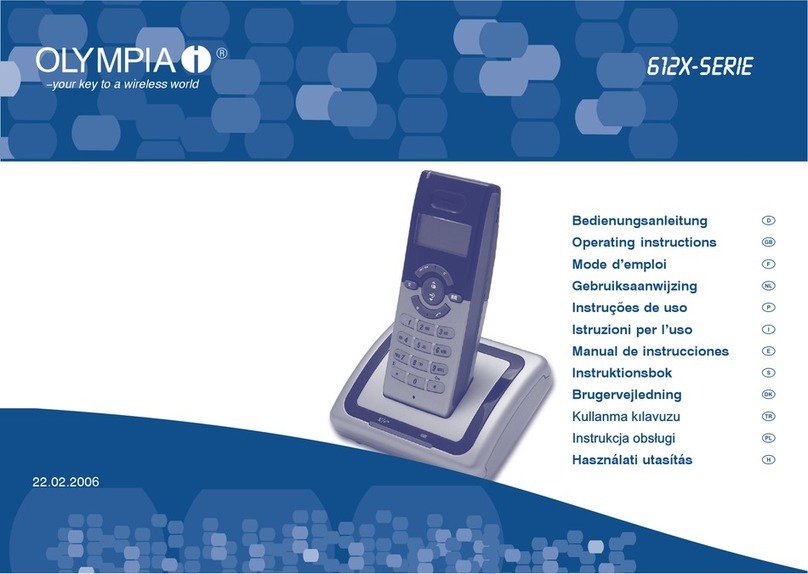
Olympia
Olympia 612X series User manual
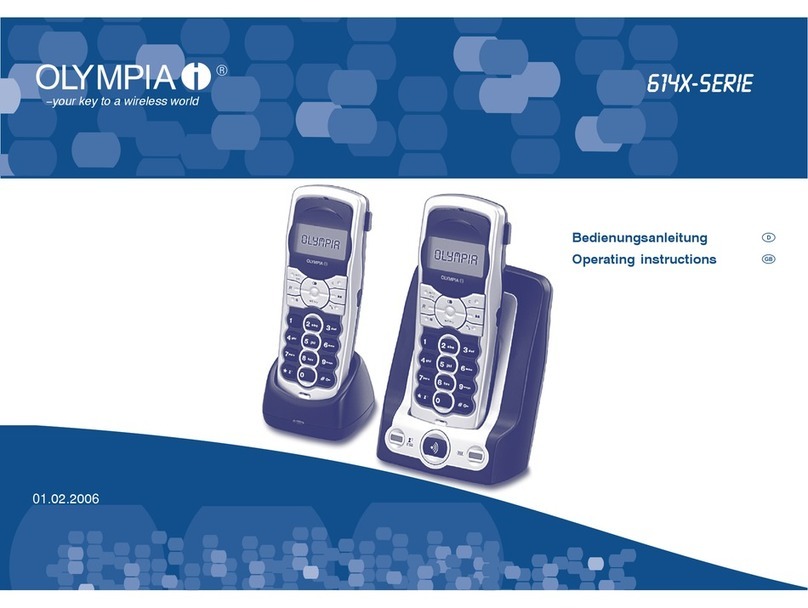
Olympia
Olympia 614X series User manual

Olympia
Olympia 6410 User manual

Olympia
Olympia CDP24106 User manual
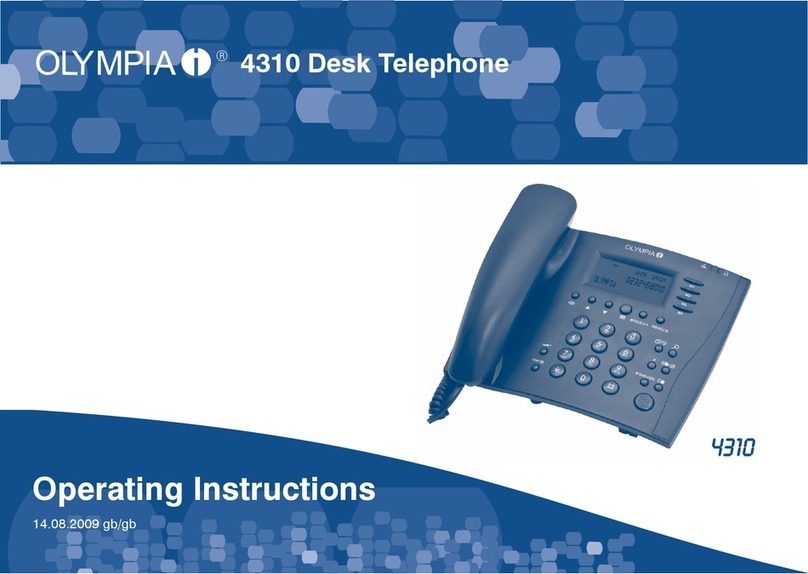
Olympia
Olympia 4310 User manual
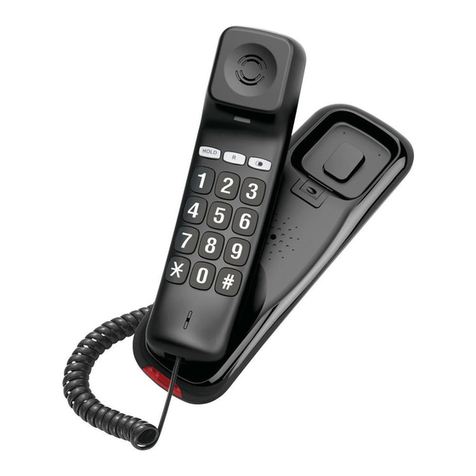
Olympia
Olympia 4510 User manual
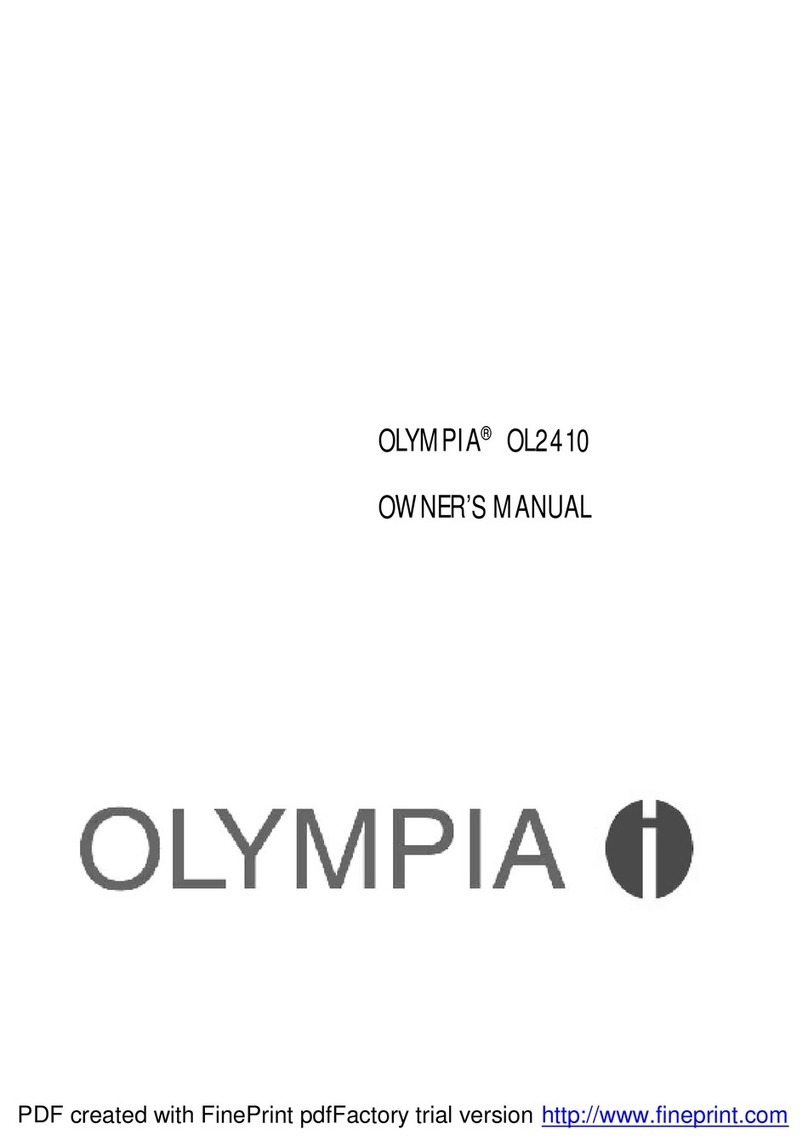
Olympia
Olympia OL2410 User manual
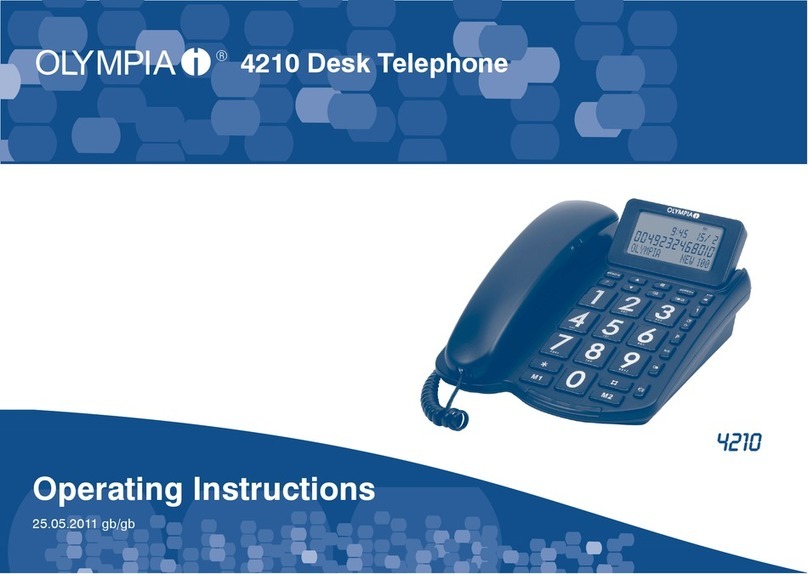
Olympia
Olympia 4210 User manual

Olympia
Olympia 4520 User manual
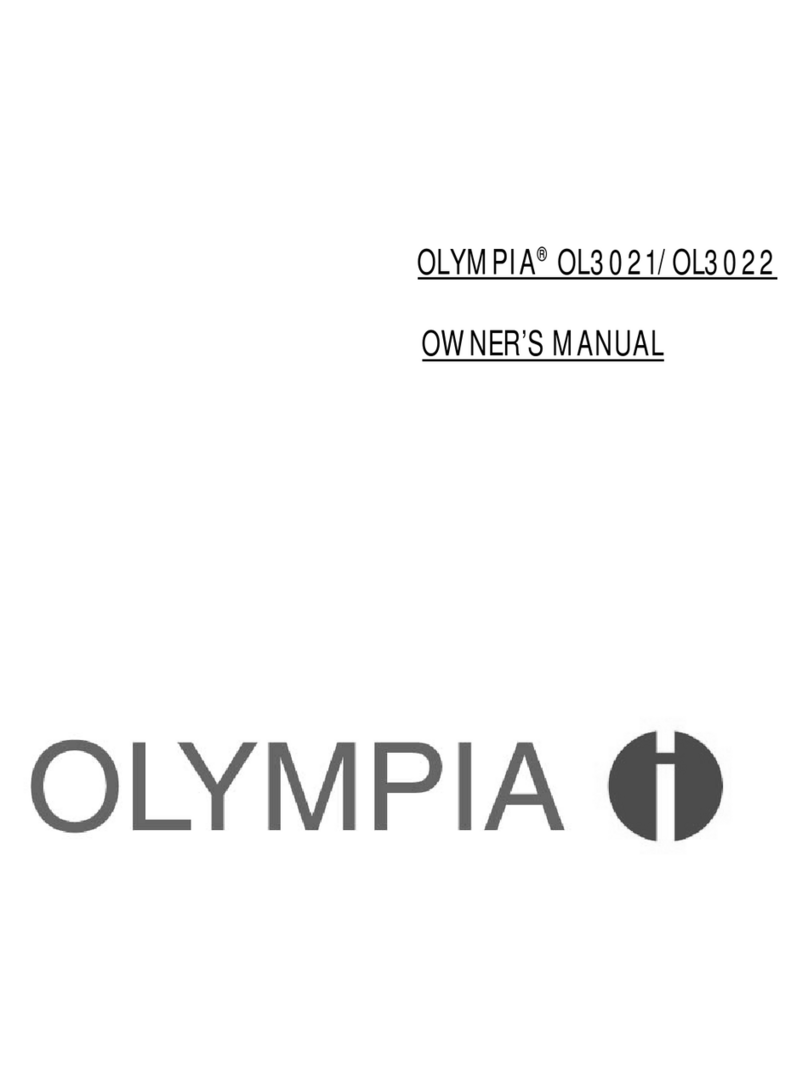
Olympia
Olympia OL3021 User manual

